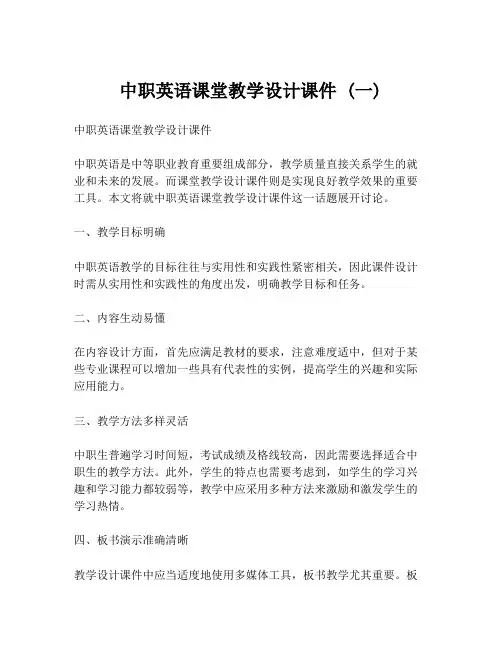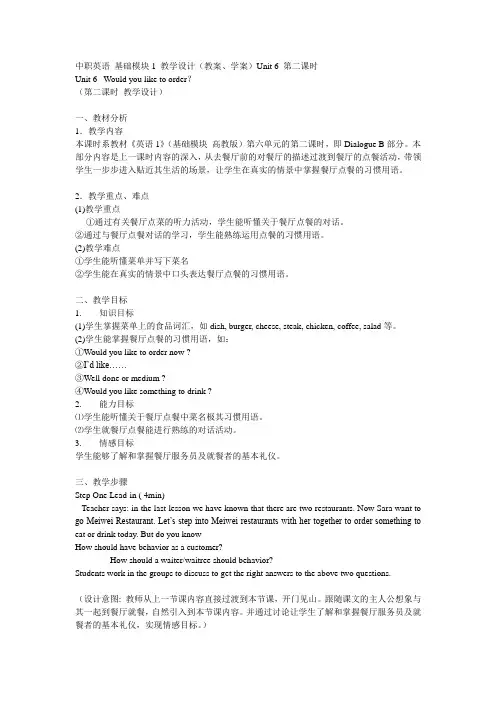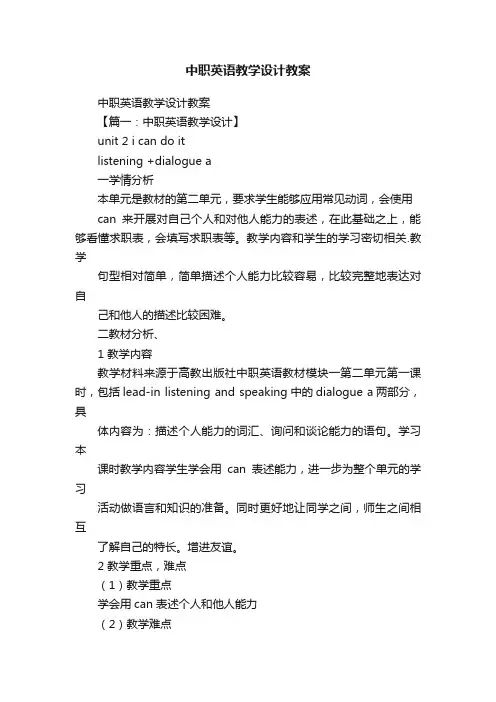中职英语教学设计教案(1)
中职英语课堂教学设计课件 (一)

中职英语课堂教学设计课件 (一)
中职英语课堂教学设计课件
中职英语是中等职业教育重要组成部分,教学质量直接关系学生的就业和未来的发展。
而课堂教学设计课件则是实现良好教学效果的重要工具。
本文将就中职英语课堂教学设计课件这一话题展开讨论。
一、教学目标明确
中职英语教学的目标往往与实用性和实践性紧密相关,因此课件设计时需从实用性和实践性的角度出发,明确教学目标和任务。
二、内容生动易懂
在内容设计方面,首先应满足教材的要求,注意难度适中,但对于某些专业课程可以增加一些具有代表性的实例,提高学生的兴趣和实际应用能力。
三、教学方法多样灵活
中职生普遍学习时间短,考试成绩及格线较高,因此需要选择适合中职生的教学方法。
此外,学生的特点也需要考虑到,如学生的学习兴趣和学习能力都较弱等,教学中应采用多种方法来激励和激发学生的学习热情。
四、板书演示准确清晰
教学设计课件中应当适度地使用多媒体工具,板书教学尤其重要。
板
书应具有准确和清晰的特点,流程和关键词应该醒目,方便学生理解和记忆。
涉及到比较重要的板书内容时,需要注明重点,以便于复习和提高学生成绩。
五、评价方式必须合理
最后,中职英语教学评价也需要重点关注。
评价方式必须更加合理,使用定量和定性结合的方式,多角度评价学生的英语听说读写四项技能,以便于更加真实和全面地了解学生的学业状态。
结论
中职英语教学设计课件对于教师讲解能力的质量和效果有着至关重要的作用。
如何更好的完成中职教学任务,以实现学生的个人发展与职业就业的目标,中职教师应该注意以上因素,并在实际中灵活运用,不断提高对中职生教学的掌握能力。
中职英语 基础模块1 教学设1

中职英语基础模块1 教学设计(教案、学案)Unit 6 第二课时Unit 6 Would you like to order?(第二课时教学设计)一、教材分析1.教学内容本课时系教材《英语1》(基础模块高教版)第六单元的第二课时,即Dialogue B部分。
本部分内容是上一课时内容的深入,从去餐厅前的对餐厅的描述过渡到餐厅的点餐活动,带领学生一步步进入贴近其生活的场景,让学生在真实的情景中掌握餐厅点餐的习惯用语。
2.教学重点、难点(1)教学重点①通过有关餐厅点菜的听力活动,学生能听懂关于餐厅点餐的对话。
②通过与餐厅点餐对话的学习,学生能熟练运用点餐的习惯用语。
(2)教学难点①学生能听懂菜单并写下菜名②学生能在真实的情景中口头表达餐厅点餐的习惯用语。
二、教学目标1. 知识目标(1)学生掌握菜单上的食品词汇,如dish, burger, cheese, steak, chicken, coffee, salad等。
(2)学生能掌握餐厅点餐的习惯用语,如:①Would you like to order now ?②I’d like……③Well done or medium ?④Would you like something to drink ?2. 能力目标⑴学生能听懂关于餐厅点餐中菜名极其习惯用语。
⑵学生就餐厅点餐能进行熟练的对话活动。
3. 情感目标学生能够了解和掌握餐厅服务员及就餐者的基本礼仪。
三、教学步骤Step One Lead-in ( 4min)Teacher says: in the last lesson we have known that there are two restaurants. Now Sara want to go Meiwei Restaurant. Let’s step into Meiwei restaurants with her together to order something to eat or drink today. But do you knowHow should have behavior as a customer?How should a waiter/waitree should behavior?Students work in the groups to discuss to get the right answers to the above two questions.(设计意图: 教师从上一节课内容直接过渡到本节课,开门见山。
中职英语教学设计教案

中职英语教学设计教案中职英语教学设计教案【篇一:中职英语教学设计】unit 2 i can do itlistening +dialogue a一学情分析本单元是教材的第二单元,要求学生能够应用常见动词,会使用can来开展对自己个人和对他人能力的表述,在此基础之上,能够看懂求职表,会填写求职表等。
教学内容和学生的学习密切相关.教学句型相对简单,简单描述个人能力比较容易,比较完整地表达对自己和他人的描述比较困难。
二教材分析、1 教学内容教学材料来源于高教出版社中职英语教材模块一第二单元第一课时,包括lead-in listening and speaking中的dialogue a两部分,具体内容为:描述个人能力的词汇、询问和谈论能力的语句。
学习本课时教学内容学生学会用can表述能力,进一步为整个单元的学习活动做语言和知识的准备。
同时更好地让同学之间,师生之间相互了解自己的特长。
增进友谊。
2 教学重点,难点(1)教学重点学会用can 表述个人和他人能力(2)教学难点表达个人能力的词汇,词组的记忆三教学目标1. 知识目标⑴掌握描述个人能力的词汇,speak chinese, drive cars, repair computers, teach english, read in chinese, serve customers. ⑵掌握询问和描述个人能力时所使用的句型,can you say something about yourself?can you sing english songs?well, i can teach english and i can speak a little chinese.2. 能力目标⑴听用情态动词can表述的有关个人能力的介绍(2)说会用can表达有关个人能力和他人能力的介绍3. 情感目标了解自己的能力欣赏自我的同时,看到他人的长处四学生分析each coin has two sides.the students in class are all boys. they prefer learning major skills to language points,they dislike english grammar and speaking english. many of them are weak at english . on the other hand they are active and energetic .they are interested in electronic products and internet .they are good at running programs in smart cell -phones and internet .it is easy for them to accept new ideas ,which is of great help to this period 五教学过程step 1 lead-in(1)talk about abilitiesplay ppt for the ss(2)look and complete.activity 1 on page23ask the students to describe each picture, using the sentence pattern “he/she/they can …” after that, the teacher may ask the students to listen to the tape and circle what ben can do.(设计意图:通过ppt快速展示名人的能力图片,引导学生学习can 的表述。
中职英语教案模板范文

一、教学目标1. 知识目标:使学生掌握本节课的单词、短语和句型,能够运用所学知识进行日常交流。
2. 能力目标:提高学生的听、说、读、写能力,培养他们的英语交际能力。
3. 情感目标:激发学生学习英语的兴趣,增强他们的自信心,培养良好的学习习惯。
二、教学内容1. 单词:table, chair, book, pen, pencil, ruler, eraser, notebook, computer, teacher, student, hello, goodbye, thank you, please, sorry, yes, no, good morning, good afternoon, good evening等。
2. 短语:How are you? I'm fine, thank you. What's your name? My name is... How old are you? I'm... years old. This is.../That is...等。
3. 句型:1. Can you help me? 2. Yes, I can. / No, I can't. 3. Where is the...? It's on the...4. What color is it? It's...5. How much is it? It's...三、教学重点与难点1. 教学重点:单词、短语和句型的掌握,日常交流能力的提高。
2. 教学难点:正确发音、语法规则和词汇运用。
四、教学过程1. 导入新课(1)教师与学生用简单的英语打招呼,如:Good morning, everyone! How are you today?(2)通过图片、实物或简短对话,引入本节课的主题。
2. 新课学习(1)教师带领学生朗读单词,让学生跟读并模仿发音。
(2)教师讲解单词、短语和句型的用法,并进行例句示范。
有关中职英语教学设计方案5篇

有关中职英语教学设计方案5篇有关中职英语教学设计方案5篇英语教学设计是英语老师做好教学的关键,为帮助各位老师做好上课前的准备。
下面是小编为你准备的中职英语教学设计方案,快来借鉴一下并自己写一篇与我们分享吧!中职英语教学设计方案【篇1】本节课是Unit 1 lesson 2 ,它是在学生理解词汇意义的基础上,结合故事内容,了解词汇的用法,然后进行模仿、并注意词汇书写形式的把握。
能运用what does……?句式对职业提问。
因此,无论是对英语知识的学习上,还是对语言的综合运用能力,都有着十分重要的作用。
学情分析:1、班级人数多。
2、学生认知水平不同。
3、语言表达能力不强。
教学目标:(1)知识目标:让学生能用英语正确的表达和书写第四页的职业名称,并运用what does……句式进行问答。
(2)能力目标:培养学生的听力和语言的综合运用能力。
(3)情感目标:通过动作、猜单词、听录音等,加深学生的学习兴趣。
重点难点:关于职业名称的学习教学过程:1、simon说用这个活动复习学过的课堂用语:stand up……2、情境引入提问学生:你的父亲是干什么的?当你遇到坏人时向谁求救?当你生病时找谁?等等。
引出单词a farmer ……放一遍录音,让学生重复,不放录音,指着录音或插图,引导学生说出单词。
3、卡片活动师指着卡片问:what does……把句子写在黑板上,并解释句子的意思。
4、进行活动,巩固知识活动一:听录音抢答老师把带有职业名称词汇的卡片发放到不同学生手中,然后放录音。
让学生听到职业名称的把卡片举起来,并用英语大声读出来。
这样使学生在竞争中很快掌握这些职业名称的读音。
活动二:猜一猜让学生看到课本第4页底部的插图,在放录音前让学生猜一猜可能听到的内容。
如猜对给予鼓励。
通过这种形式使学生在娱乐中反复操练,并培养了学生的听力。
活动三:找朋友将学生分成两组,并发给学生每人一张卡片,在另一组必定有一人持有一张含有相对应的英语职业名称的卡片。
中职英语第一册教案

中职英语第一册教案【篇一:中职英语教案】基础模块unit 9《getting around》参赛教师:李婧婧(大连市轻工业学校)一、学情分析我所授课的班级是数控专业二年级学生。
具体分析及解决办法列表如下:二、教材分析1、教学内容使用的是外研社的中等职业学校英语教材基础模块第一册,本书在学习内容的设置上贴近学生生活,符合职业需求,听说读写的教学活动设计灵活多样,语言地道实用。
本课选自本书的第六单元,课题是“getting around”课型是lead-in and speaking.内容涉及的是学生们日常生活中必须掌握的关于指路、问路的基本用语。
2、教学重点、难点重点:用于指路和问路的基本句型和表达。
问句:where is / can we find …?how can i get to…?could you show me the way to…? is there a… near / around here?we are looking for …答句:it’s + 介词+ 参照物.it’s near / far from here.you may take + 交通工具 / get there by + 交通工具you can’t miss it. sorry, i don’t know.难点:能结合具体的生活场景,准确地使用所学句型进行真实的会话。
3、教学目标(1)知识与能力目标:基础层:能识别基础的地点名称,听懂问路的问题,自主提问。
使用简单的指路问路的句型进行会话。
提高层:能使用多种方式进行问路和指路的语句,在学习资料的辅助下能够自主的组织问路指路的会话,提高自己的学习能力,改善自己的学习方法(2)过程与方法目标:①通过开展小组讨论与探究,培养有效搜集信息、判断信息、整理信息与应用信息的方法。
②通过开展自评、生评、师评等多元评价,形成正确认识与评价自我及他人。
(3)情感、态度价值观目标:①培养英语学习兴趣,获取正确学习方法。
中职英语 基础模块1 教学设计
中职英语基础模块1 教学设计(教案、学案)Unit 1【教学策略】1. Let students master the phonetics and spelling to pronounce words, phrases and sentences correctly.2. Let the students work in pairs to make the conversations by themselves.3. Ask questions and help the students to understand the main idea the lesson.4. Listen more and improve the listening ability step by step, keep the sound symbol in mind.5. Assign the students some homework.6. Review what the students have learned.【教学过程组织】Teaching processStep One :1.The teacher greets each student: Good morning. Nice to meet you. May I have your name, please? Which school are you from? What do your parents do?2.Brainstorm the ways of greeting a person. Possible answers:Good morning/afternoon/evening.Hi./Hello. Nice to meet you. How do you do? How are you?/ How are yougoing? (collect different answers on the blackboard)3.Let’s make it a rule: Let’s greet each other at the beginning of each English lesson, using the following patterns. Teacher:Class begins.The monitor: Stand up. Teacher: Good morning/afternoon, boys and girls. Students: Good morning/afternoon, teacher.Teacher: How are you today? Students: We are fine. And you?Teacher: I’m fine, too. Thank you. Sit down, please.4. Activity 3. Act and practice. How would you greet a person in the following situations?Step Two: Listening and speaking ( 10 m)1.Activity 4. Listen and underline.Listen to dialogue A and underline the sentences about greeting a person.2.Practice a similar dialogue with your partner.3.Activity 8. Listen and complete. Listen to dialogue B , and fill in the following form.4.Guess the meaning of “last name” and “first name”.5.Activity 9. Read and underline. Practice the dialogue with your partner and underline the sentences about asking one’s personal information.6.Make a similar dialogue with the classmates around you. Sample A:Good morning! I’m Lu Zhongnan. Lu is my last name and Zhongnan is my first name. May I have your name, please.B: Good morning! I’m Lin Chunning. Lin is my last name and Chunning is my first name.A:Nice to meet you. I’m from No. 7 Middle school. Where are you from?B: Nice to meet you, too. I’m from No.15 Middle school.7.Ask some pairs to demonstrate their performance(greet each other and ask for personal information).8.Activity 12. Talk and complete. Talk to five classmates and ask about their first name, last name and which school they are from. And then fill in the form.Step Two: Readinging and writing ( 15 m)1.Activity 13. Read and tick. Which of them may be included in a name card?2. Activity 14. Read and check.Answer the following questions.3. Activity 15. Read and complete. Ask the students to do it as quickly as possible. The first ten fastest can get a small prize.4. Now would you please design a creative name card for Mrs. Hu?5.Can you design a name card for yourself? (Imagine a future company and a future job for yourself)6.Ask some students to design their name cards on the blackboard. Make some comments.7.Show each student or each group a name card. Ask the students to talk about the information in the name card.【小结】Step Three: Summary and Production ( 5 m)1. Make a short summary of what we’ve learned today.(1)key vocabulary. (2)everyday English about greetings and personal information.2.Think of ten ways of greetings.3.Remember how to design a personal name card.【学生学习情况检测】( 2 m)1. Practice the dialogue with your partner and underline the sentences about asking one’s personal information.2.Show each student or each group a name card. Ask the students to talk about the information in the name card.【作业及思考】Step Four: Homework ( 1 m)1. Practice dialogue B with your classmate after class.2. Make a similar dialogue, talking about personal information.3. Make an introduction of your classmate.4. Copy key vocabulary five times in English ang one time in English.5.design a special name card for yourself.。
中职英语教学设计教案
中职英语教学设计教案一、教学目标1. 知识目标:(1)学生能够掌握基本的英语语法和词汇。
(2)学生能够进行简单的英语听说读写练习。
(3)学生能够理解日常生活中的英语对话。
2. 技能目标:(1)学生能够运用英语进行自我介绍和日常交流。
(2)学生能够阅读和理解简单的英文文章。
(3)学生能够书写简单的英文作文。
3. 情感目标:(1)学生能够增强学习英语的兴趣和自信心。
(2)学生能够积极参与英语学习活动。
二、教学内容1. 课程主题:日常生活中的英语对话2. 教学重点:(1)动词时态的运用。
(2)日常英语口语表达。
3. 教学难点:(1)不规则动词的过去式形式。
(2)复杂句型的运用。
三、教学方法1. 任务驱动法:通过设定实际生活中的任务,激发学生的学习兴趣和积极性。
2. 情景教学法:创设真实的语言环境,让学生在实际情境中学习和运用英语。
3. 互动式教学法:鼓励学生积极参与课堂活动,提高学生的英语交际能力。
四、教学步骤1. 热身活动(5分钟):通过简单的英语歌曲或游戏,激发学生的学习兴趣。
2. 新课导入(10分钟):介绍本节课的主题,展示相关图片或实物,引导学生进行观察和思考。
3. 知识讲解(15分钟):讲解本节课的重点语法和词汇,并通过例句进行说明。
4. 实践环节(15分钟):分组进行角色扮演,让学生在实际情境中运用所学知识进行对话。
五、教学评价1. 课堂参与度:观察学生在课堂活动中的积极参与程度和表现。
2. 作业完成情况:检查学生作业的完成质量和进度。
3. 口语测试:通过小组对话或个人陈述,评估学生的口语表达能力。
4. 单元测试:定期进行单元测试,了解学生的学习效果。
六、教学资源1. 教材:选用适合中职学生的英语教材,如《中职英语》等。
2. 辅助材料:提供相关的英语图片、视频、音频等资源,以便在教学中进行直观展示。
3. 网络资源:利用互联网资源,如在线英语学习网站、英语学习APP等,为学生提供更多的学习资料和实践机会。
中职英语教学设计模板5篇
中职英语教学设计模板5篇中职英语教学设计模板篇1课前准备1.教学挂图。
2.教学投影片。
3.教学录音磁带。
4.学生画图用白纸(教师准备)。
教学内容A Listen and find.1.本部分提供了一幅迷宫游戏图。
2.学生根据图和录音材料,找出图中人物要去的地方,并划线表示出来。
3.本部分通过听和找的活动,检测学生对本单元学习内容的听和认的情况。
4.为了降低听力材料的难度,每一项听力材料都是由两句话组成,先说某人去哪儿,再说乘什么交通工具。
5.图中的路线可以重复画。
B Lets make a mural and talk.1.本部分是一项学生自主活动。
学生以小组为单位,画一幅街道的图画(mural意为:壁画;天花板的装饰画)。
2.本部分提供了一幅学生画习作,供学生小组活动时参考。
3.学生绘画结束后,应对本组的作品集体进行描述,以此来检测自己对本单元学习内容的说的情况。
教学建议1.教师出示本课教学挂图,要求学生用“I can see....”语句对图画进行简单描述。
2.教师请学生猜一猜画面上人物要去哪儿,引导学生说出在本单元学到的交际用语(注意:说本单元交际用语时需要换人称,教师可以帮助学生说,如:教师说前半句Andy is,学生接后半句going to the supermarket.)。
3.学生听录音并画线。
该练习做完后要有反馈,教师要帮助学生核对答案。
核对答案时学生可以互相交换课本,以逐步学会互相检查。
4.教师将学生分成4至5人一组,每组发一张白纸,要求学生以组为单位,画出想象中的街道。
教师也可以给出街道示意图(如下图),请学生添加画面。
这项练习的另外一个做法是:课前布置任务,学生同样以组为单位,收集有关街道建筑、设施、车辆的图片,并将图片剪下来带到课堂。
课堂活动时,大家有选择的将自己收集到的图片贴在一起,组成街道拼贴画。
为防止大家都找同一类型的图片,布置任务时教师可以指导学生进行分工。
5.图画作品完成后,让学生先在组内用英语对图画进行描述。
中职英语教学设计
中职英语教学设计(经典版)编制人:__________________审核人:__________________审批人:__________________编制单位:__________________编制时间:____年____月____日序言下载提示:该文档是本店铺精心编制而成的,希望大家下载后,能够帮助大家解决实际问题。
文档下载后可定制修改,请根据实际需要进行调整和使用,谢谢!并且,本店铺为大家提供各种类型的经典范文,如工作计划、工作总结、述职报告、演讲致辞、心得体会、职业规划、合同协议、教学资料、作文大全、其他范文等等,想了解不同范文格式和写法,敬请关注!Download tips: This document is carefully compiled by this editor. I hope that after you download it, it can help you solve practical problems. The document can be customized and modified after downloading, please adjust and use it according to actual needs, thank you!Moreover, this store provides various types of classic sample essays for everyone, such as work plans, work summaries, job reports, speeches, insights, career plans, contract agreements, teaching materials, complete essays, and other sample essays. If you want to learn about different sample formats and writing methods, please stay tuned!中职英语教学设计中职英语教学设计模板作为一名无私奉献的老师,常常要根据教学需要编写教学设计,教学设计是一个系统设计并实现学习目标的过程,它遵循学习效果最优的原则吗,是课件开发质量高低的关键所在。
- 1、下载文档前请自行甄别文档内容的完整性,平台不提供额外的编辑、内容补充、找答案等附加服务。
- 2、"仅部分预览"的文档,不可在线预览部分如存在完整性等问题,可反馈申请退款(可完整预览的文档不适用该条件!)。
- 3、如文档侵犯您的权益,请联系客服反馈,我们会尽快为您处理(人工客服工作时间:9:00-18:30)。
英语教学设计教案
教学设计过程
Step I Leading-in and Pre-reading
1. Asking some questions:
a) What is the most traditional holiday of China?
Spring Festival
b) What is the most traditional holiday of America?
Thanksgiving Day
2. Play the footage of the original of Thanksgiving.
Let the students think over and discuss the original of Thanksgiving and celebrated time.
Step II Fast reading.
Let the students scan the text to get some information about the text and then answer the following questions.
a)When is Thanksgiving Day always celebrated ?
It’s always celebrated on the fourth Thursday in Novemeber.
b)What are the Thanksgiving Day main dishes?
The main dishes for Thanksgiving Day are turkey and pumpkin pie.
Step III Intensive Reading
1.Let the students carefully read the text and accomplish Comprehension
Exercises
Comprehension Exercise
1) Thanksgiving Day is the most traditional holiday of _________.
A. India
B. America
C. Canada
D. Japanese
2) The first Thanksgiving Day was held in Massachusetts in ________.
A. 1820
B.1683
C. 1621
D. 1863
3) They invited their Indian friends to ______ a big feast.
A. take part in
B. have
C. cook
D. celebrate
4) The main dishes for Thanksgiving Day are _______ and pumpkim pie.
A. fish
B. chicken
C. beef
D. turkey
5) Thanksgiving Day was officially revived by ________ in 1863.
A. Lincoln
B. Marco Polo
C. Diana
D. Frankfurt
6) Thanksgiving Day is not only a day to give thanks to ______ but also
a day for the family to get together.
A. Pilgrims
B. farmer
C. Indian
D.God
Step IV Words Searching
Competition in groups
The purpose of this step is to revise and consolidate the knowledge they learn
Step V Discussion
Divide the students into a few groups, discuss the following questions
1.Who do you want to give thanks?
2.How do you express your thanks? What will you do?
Step VI Summary and Homework
Summary:
We know that Thanksgiving Day is celebrated on the fourth Thursday in November. And the main dishes are turkey, pumkim pie. It’s the day for family members to get together and give thanks to each other.
Homework
Fill in the blanks with the proper form of the words given below.
1.
2.Spring Festival is the most ________ holiday in China.
3.My friends __________ me to join them for dinner.
4.You will meet _______ problems in a new place.
5.A sports meeting will be ________ at the Saturday morning.
6.I’m a ______ of the class.
Step VII Blackboard design
•celebrate V. 庆祝,称颂
celebration n. 庆祝活动 in celebration of , for the celebration of
为了庆祝…, 为了祝贺…
•revive V. 复活使苏醒
•give thanks to 感谢…
•invite sb. to do sth. 邀请某人做某事
•join in 参加比赛或具体活动
take part in 参加活动(强调主语参加该活动,并在活动中起积极作用)
attend 参加会议(强调发生这一动作本身,并不在于参加者起作用与否)
•not only…but also…不但…而且…
1) 连接并列主语时,谓语动词按就近一致原则
2)连接并列分句时,前一分句用倒装,后一分句用陈述语序。
